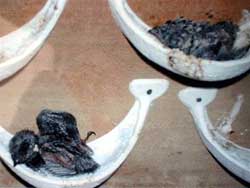In early January, with over 90% of the sixth batch of swiftlet eggs hatching and a fledgling rate reaching 30%, Mr. Vo Thai Lam, the director of Yen Viet Co., Ltd., confidently asserted that the climatic conditions of Ninh Thuan are entirely suitable for swiftlets to migrate and settle. He believes that with the right investment, raising swiftlets commercially in Ninh Thuan could become a “unique” profession in the country.
A Suitable Habitat…
 |
| Swiftlets hatching for over a month (Photo: TTO) |
Mr. Vo Thai Lam, the director of Yen Viet Co., Ltd., recounted that after reading an article in Tuổi Trẻ about the appearance of a flock of over 100 swiftlets in the premises of the Ninh Thuan Song and Dance Troupe in the center of Phan Rang Town (Tuổi Trẻ, March 25, 2004), the idea of raising swiftlets at home began to take shape in his mind.
To pursue this idea, in early 2005, this daring director, along with a colleague from the company, self-funded their participation in a training course for swiftlet farming technicians in Indonesia and visited the Par Panang swiftlet village in Thailand to study the farming model of this valuable bird.
In April 2005, Mr. Lam boldly proposed and received approval from the provincial People’s Committee to implement a project to protect and develop the natural swiftlet population at house number 592 Thong Nhat. Yen Viet Co., Ltd. was officially established.
Results from genetic testing by the Paris Institute of Science and Technology indicated that the swiftlets residing in Phan Rang (Ninh Thuan) belong to the Aerodramus genus, specifically the A.fuciphagus species. According to research by biologist Dr. Nguyen Khoa Dieu Thu, this species has an average length of 12 cm and weighs between 12-20 grams, with a dark brown body.
In Vietnam, the A.fuciphagus species is commonly found in islands belonging to several provinces such as Khanh Hoa, Da Nang, Binh Dinh, and Kien Giang. Therefore, the migration of this species to Phan Rang is quite an unusual phenomenon.
Prospects for a New Profession
The house at 592 Thong Nhat was renovated to attract the swiftlets: all ventilation holes and windows were sealed, leaving only a large gap at the top for the birds to enter and exit. The walls were soundproofed, and a misting system was installed at various points throughout the house to continuously operate… Mr. Lam explained that swiftlets are very sensitive creatures.
To keep them, it is essential to create a suitable environment in terms of darkness, temperature (around 28°C), and humidity (95%), while also minimizing noise…
With a flashlight illuminating our path, it was fascinating to see hundreds of swiftlet nests shaped like inverted bowls evenly distributed across the ceiling and walls, along with dense flocks of swiftlets flying around.
Mr. Lam noted that to prevent the birds from experiencing shock, the company decided to purchase the neighboring house (number 594) late last year and continued renovations to build nests to attract the birds. Surprisingly, just over a month later, around 100 birds had naturally moved to the new nests. “Currently, the swiftlet population in the company has grown to over 2,000 birds,” Mr. Lam stated.
Last October, Yen Viet Co., Ltd. decided to undertake a bold initiative: artificially incubating swiftlet eggs. “Hatching the eggs is not difficult; the most challenging part is raising the chicks to ensure they can integrate with the flock and fly to forage after 45 days,” Mr. Lam explained.
After five consecutive failures (with only a 1-2% survival rate for the chicks), the sixth batch in early January yielded unexpected results: 90% of the eggs hatched, with a fledgling rate of 30%.
Yen Viet Co., Ltd. is proposing to the provincial People’s Committee to organize a scientific workshop to replicate the model of indoor swiftlet farming for commercial purposes. “We are ready to share our experiences with the locals in the province with the goal of establishing a “unique” swiftlet farming community in the near future,” Mr. Lam said.
L. TRUONG



















































